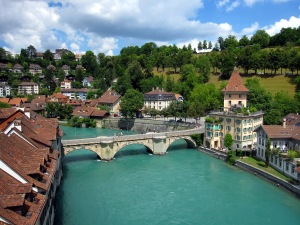
View from Männlichen into the Grindelwald valley
In German, the word for hiking is wandern, and can be expanded to mean anything from migrating, journeying and wandering. And indeed, you can do quite a lot of hiking in Switzerland simply by wandering from signpost to signpost on the country’s 50,000 km of marked trails. Even the smallest mountain outposts are easily found via an intricate system of wanderwege routes (marked by yellow signs) found between lakes, valleys and towns, higher altitude bergwege mountain paths (marked by white-red-white blazes), and rugged alpine routen trails (marked by white & blue blazes) that can include steep drop-offs and sections with cables or handholds.
Since the phrase “relaxing vacation” is not in our vocabulary, Britton and I spent our last day in Berner-Oberland hiking. The guide at Balmer’s suggested taking the train from Interlaken to Wengen (with a train transfer at Lauterbrunnen). Round-trip tickets for this cost about CHF 25. From Wengen (1,274 m), we would hike the route to In Gassen and Männlichen (2,227 m), then walk along the mountain ridge to Kleine Scheidegg (2,061 m), and finally trek downhill from Kleine Scheidegg toward Wengernalp back to Wengen. On the Jungfraubahnen Wandern map, that would be routes 46, 33 and 41.
The morning was marked with a heavy downpour and ominously thick cloud cover, and I silently fretted about what we were going to do if the rain didn’t ease. Fortunately, the skies cleared at about 10:30 am, and we set off with backpacks full of bread, cheese, salame and light clothing. Personally, I think that hiking in sneakers is often safer than using thick-soled hiking boots because you will have a better feel for the terrain. Besides, hiking boots are heavy, and that extra weight goes a long way when you are scaling a mountain. The same goes for hiking poles; they can be helpful if you’re going downhill, but for the most part, you’re better off using your hands for balance and feet to feel the ground. I had to laugh at the hikers decked out in shiny layers of North Face and poles on flat sections of trail. Newbs.
Continue reading Hiking the Männlichen Summit →












